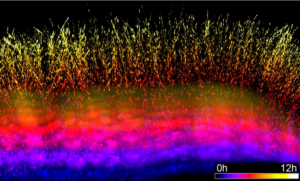EARC wins funding for microscope that will allow scientists to observe delicate cells
06 October 2022

Growth of Candida albicans over half a day, imaged using light-sheet microscopy. This human pathogen can form thin films on voice prostheses and catheters. A better understanding of how it grows can help us identify new ways to prevent it. Time is colour-coded, showing the start of growth in blue (0h) and ending in yellow-white (12h). Image credit: Philippe Laissue, Campbell Gourlay Dan Pentland and Intelligent Imaging Innovations.
The Biotechnology and Biological Sciences Research Council (BBSRC) has awarded Eastern Arc a £480k grant for a state-of-the-art lightsheet microscope that will enable scientists to observe delicate cells, tissues and whole organisms without damaging them with intense light.
Dr Philippe Laissue, who led the bid and will host the facility at the University of Essex, explained why this is so important. ‘Microscopy has turned into an incredibly exciting area of research over the last two decades, with several recent Nobel Prizes and many new technological developments.
‘However cells are easily damaged if intense light is focussed on them – and many conventional microscopy techniques use very bright light.
‘Lightsheet microscopy can solve this issue by providing good images at low light intensity. Using a ‘sheet’ or plane of light, cells can be observed gently over days and without damage, producing breathtaking movies. So getting this light-sheet microscope is a fantastic opportunity and enables us to do research that is not possible with any other technique.’
Together with collaborators across the Eastern Arc, Laissue will use the high-end light-sheet microscope in combination with cutting-edge software to address new and exciting biological questions in biomedical and environmental research.
The collaboration is the first step in a new ‘Imaging Platform Alliance’ between the EARC universities. A memorandum of understanding was signed by the pro-vice-chancellors of UEA, Essex and Kent in July, and a framework of access, costing and support is currently being developed.
‘This is a really exciting initiative for Eastern Arc,’ said Phil Ward, the consortium director. ‘Sharing equipment not only enables colleagues to access facilities that they may not have at their own institution, but opens up opportunities for collaboration, exploration, and shared working. Not only that, but we hope it will offer a chance for our technicians to work together and thereby develop knowledge and insights that will benefit their home institutions and their own careers. By sharing equipment, everyone wins.’
More detail on the Imaging Platform Alliance will be available later in the year, with a dedicated webpage and details of how members of Eastern Arc can use equipment across the consortium.
